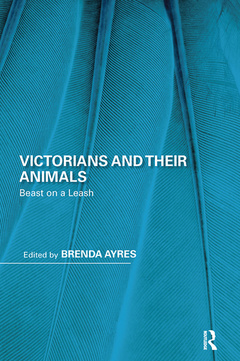Victorians and Their Animals Beast on a Leash Perspectives on the Non-Human in Literature and Culture Series
Coordonnateur : Ayres Brenda

Victorians and Their Animals: Beast on a Leash investigates the notion that British Victorians did see themselves as a naturally dominant species over other humans and over animals. They were conscientiously, hegemonically determined to rule those beneath them and the animal within themselves, albeit with varying degrees of success and failure. The articles in this collection apply posthumanism and other theories, including queer, postcolonialist, deconstructionist, and Marxist approaches in their exploration of Victorian attitudes toward animals. They study the biopolitical relationships between human and nonhuman animals in several key Victorian literary works. Some of this book?s chapters deal with animal ethics and moral aesthetics. Also being studied is the representation of animals in several Victorian novels as narrative devices to signify class status and gender dynamics, either to iterate socially acceptable mores, to satirize hypocrisy or breach of behavior or to voice social protest. All of the chapters analyze the interdependence of people and animals during the nineteenth century.
List of Figures
Preface and Acknowledgments
Introduction: Beast on a Leash
BRENDA AYRES
1 Gaskell’s Activism and Animal Agency
BRENDA AYRES
2 Old and New Beef: Caring for Animals in Household Words
LIAM YOUNG
3 George Eliot’s Use of Horses in Measuring the Moral Maturity of Characters in Her Novels
CONSTANCE M. FULMER
4 Pigs in Great Expectations: Class, Dehumanization, and Marxist Animal Studies
JESSICA KUSKEY
5 Ants, Insects, and Automatons: Classifying Creatures in Hardy's The Return of the Native
ANNA WEST
6 It’s Raining Cats and Dogs in the Novels of George Eliot
BRENDA AYRES
7 A Fine Kettle of Fish: Cultural (and Culinary) Preservation in Anglo-Jewish Ghetto Stories
LINDSAY KATZIR
8 Gendered Metamorphoses in the Natural History Museum and Trans-Animality in Richard Marsh’s The Beetle
PANDORA SYPEREK
9 The "Animality" of Speech and Translation in The Jungle Books
CHRISTIE HARNER
Notes on Contributors
Index
Brenda Ayres teaches English for Liberty University in Lynchburg, Virginia, and has previously edited several collections of essays. The most recent is Biographical Misrepresentations of British Women Writers: A Hall of Mirrors and the Long Nineteenth Century (2017). Her latest monograph is Betwixt and Between: The Biographies of Mary Wollstonecraft (2017). She published her first article on animals in Victorian literature in The George Eliot–George Henry Lewes Newsletter (1991), titled "Dogs in George Eliot’s Adam Bede." She began collecting information on the subject when she created a panel at the Southern Conference of British Studies in 2000 titled "Animals in Victorian Literature" and presented "The Iconization of Animals in Victorian Culture." Two years later she spoke on "Beast on a Leash: Victorian Dominion over the Animal Kingdom" at the Mid-Atlantic Popular Conference.
Date de parution : 09-2020
15.2x22.9 cm
Date de parution : 12-2018
15.2x22.9 cm
Thème de Victorians and Their Animals :
Mots-clés :
Young Man; Animals; Bar Ashi; Children; Vanden Bossche; Evolution; Animal Kingdom; Law; Tartar Emetic; Separate spheres; Mental Evolution; Hunting; Daniel Deronda; Youth; Fried Fish; Exhibitions; Moral Immaturity; Judaism; Swinish Multitude; Domesticity; Smithfield Market; Literature; Beatrix Potter’s Peter Rabbit; Science; Master Word; Race; Jungle Books; Aristocrat; Gefilte Fish; Africa; Household Words; Friendship; Egdon Heath; Food Supply; Landseer’s Painting; Periodicals; Kipling’s Stories; Immoral; Nonhuman Animals; Abortion; Mowgli Story; Government; Early Nineteenth Century Political Economy; Cities; Late Nineteenth Century British Imperialism; Patriarchy; Metropolitan Cattle Market; Anglican; Beetle’s Emergence; Methodist; Church of England; Agriculture; Pauperism; Poor Law; Poor; Poverty; Social mobility; Utilitarianism; Marriage; Pregnancy; Crime; Anti-Semitism; Museums; Racism; Venereal disease; Asylums; 19th Century British Literature; Insanity; 19th Century English Literature; Homosexuality; 19th Century Literature; Nationalism; British Victorian Literature; Hindu; Ecocriticism; Literacy; Elizabeth Gaskell; Colonies; English Victorian Literature; Relationships; George Eliot; Great Expectations; Hardy; Marxism; The Return of the Native; Victorian Literature; animal culture; automatons; beast; beef; cats; class; control; dehumanizing; dogs; dominance; dominant species; fairy tales; fish; human lives; humane treatment of animals; insects; interdependence; man; metaphorical animals; natural history; non-human; nursery rhymes; people; religion; the beetle; Brenda Ayres; Liam Young; Constance M; Fulmer; Jessica Kuskey; Anna West; Lindsay Katzir; Pandora Syperek; Christie Harner; animal ethics; moral aesthetics; Victorian human relationships; Victorian nonhuman relationships



